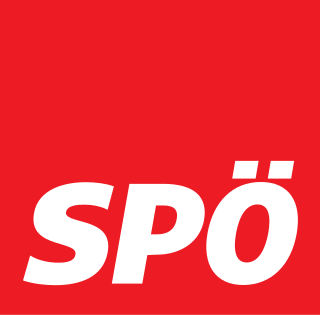
The politics of Austria take place in the framework of the federal parliamentary republic of Austria, with a President as head of state, and a Chancellor as the head of government. Governments, both local and federal, exercise executive power. Federal legislative power is vested both in the Federal Government and in the two chambers of Parliament; the National Council and the Federal Council. The Judiciary of Austria is independent of the executive and the legislature.

Parliamentary elections were held in Austria on 3 October 1999.
Knittelfeld Putsch refers to a conference of the Freedom Party of Austria (FPÖ) which took place on 7 September 2002 in the small Austrian town of Knittelfeld, Styria, called due to political differences within the party leadership. The events resulted in early federal elections in the same year.

The 2006 general election for the National Council in Austria was held on 1 October 2006.

Snap legislative elections were held in Austria on 28 September 2008 to elect the 183 members of the National Council. The elections were caused by the withdrawal of the Austrian People's Party (ÖVP) from the governing grand coalition with the Social Democratic Party on 7 July 2008. Due to dissatisfaction with the grand coalition and the two main parties, it was widely expected to be a realigning election, with gains for the opposition and up to seven parties were expected to win seats.
The political parties used numerous campaign posters in the 2008 Austrian legislative election.

The Carinthian state and municipal elections of 2009 were held in the Austrian state of Carinthia on 1 March 2009. Carinthia is the stronghold of the national conservative Alliance for the Future of Austria, whose founder Jörg Haider died in a car accident on 11 October 2008. He was also the incumbent governor; after his death, he was replaced by Gerhard Dörfler as governor, by Uwe Scheuch as Carinthian BZÖ leader and by his close personal friend Stefan Petzner as national BZÖ leader. The election is likely to see a strong contest between the SPÖ and the BZÖ over the post of governor, while the other Austrian parties play only a minor role in Carinthian politics.

The Austrian presidential election took place on 25 April 2010. It was the twelfth election of an Austrian head of state since 1951. The candidates were President Heinz Fischer, Barbara Rosenkranz (FPÖ) and Rudolf Gehring (CPÖ). Heinz Fischer won with just under 80% of the valid votes. The turnout was on the historic low of about 54%.

Jörg Haider was an Austrian politician. He was Governor of Carinthia on two occasions, the long-time leader of the Austrian Freedom Party (FPÖ) and later Chairman of the Alliance for the Future of Austria, a breakaway party from the FPÖ.
The Freedom Party in Carinthia was a political party in Austria, operating in the federal state of Carinthia.
This article covers the formation of the Faymann cabinet following the 2008 parliamentary election in Austria.

The Team Stronach, full name Team Stronach for Austria, was a Eurosceptic and right-wing populist political party in Austria founded by and named after Austrian-Canadian businessman Frank Stronach. It was dissolved in August 2017.
A legislative snap election for the National Council in Austria was held on 28 September 2008. The previous election was held on 1 October 2006. The election was caused by the withdrawal of Austrian People's Party leader Wilhelm Molterer from the governing grand coalition on 7 July 2008. Due to dissatisfaction with the grand coalition and the two main parties, it was widely expected to be a realigning election, with gains for the opposition and up to seven parties expected to be in the National Council after the election. The losses for the government parties resulted in strong gains for the far right, while neither the Liberal Forum nor the Citizens' Forum Austria gained as much as 2% of the vote, defying earlier expectations. The result of the election was seen as strong for the far-right and in support of Eurosceptics.
A legislative snap election for the National Council in Austria was held on 28 September 2008. The previous election was held on 1 October 2006. The election was caused by the withdrawal of Austrian People's Party leader Wilhelm Molterer from the governing grand coalition on 7 July 2008. Due to dissatisfaction with the grand coalition and the two main parties, it was widely expected to be a realigning election, with gains for the opposition and up to seven parties expected to be in the National Council after the election. The losses for the government parties resulted in strong gains for the far right, while neither the Liberal Forum nor the Citizens' Forum Austria gained as much as 2% of the vote, defying earlier expectations. The result of the election was seen as strong for the far-right and in support of Eurosceptics.

The 2014 European Parliament election was held on 25 May 2014 in Austria. As a result of the Lisbon Treaty Austria held 19 seats in the European Parliament, but with Croatia joining the Union in 2013, Austria's allocation was reduced to 18 seats.

Legislative elections were held in Austria on 15 October 2017. The Austrian People's Party (ÖVP) emerged as the largest party in the National Council, winning 62 of the 183 seats. The Social Democratic Party (SPÖ) finished second with 52 seats, slightly ahead of the Freedom Party of Austria (FPÖ), which received 51 seats. NEOS finished fourth with 10 seats, and PILZ entered parliament for the first time and came in fifth place with 8 seats. The Green Party failed to cross the 4% threshold and was ejected from parliament, losing all of its 24 seats.




























